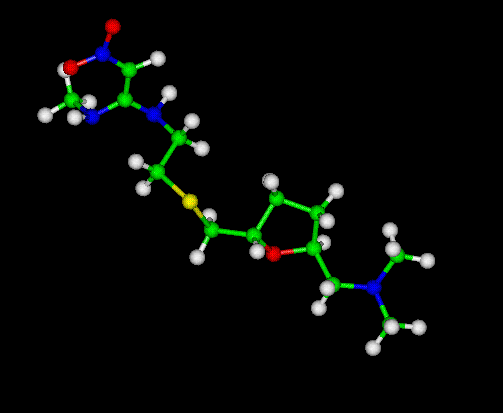Zantac -- Ranitidine
Ranitidine is a histamine H2-receptor antagonist that inhibits stomach acid production. It is commonly used in the treatment of peptic ulcer disease (PUD) and gastroesophageal reflux disease (GERD). It is currently marketed over the counter under the trade name Zinetac and Zantac by GlaxoSmithKline and by many other companies under various other names.
Clinical Use
Certain preparations of ranitidine are available over the counter (OTC) in various countries. In the United States, 75 mg and 150 mg tablets are available OTC. In Australia, packs containing 7 or 14 doses of the 150 mg tablet are available in supermarkets, small packs of 150 mg and 300 mg tablets are Schedule 2 Pharmacy Medicines. Larger doses and pack sizes still require a prescription. Outside of the United States, ranitidine is combined with bismuth (which acts as a mild antibiotic) as a citrate salt (ranitidine bismuth citrate, TritecŪ), to treat Helicobacter pylori infections. This combination is usually given with clarithromycin, another antibiotic.
History and development
Ranitidine was developed by Glaxo (now GlaxoSmithKline) in an effort to match the success of Smith, Kline & French (also now GlaxoSmithKline) with the first histamine H2-receptor antagonist cimetidine. Ranitidine was the result of a rational drug-design process using what was by then a fairly refined model of the histamine H2-receptor and quantitative structure-activity relationships (QSAR). Glaxo refined the model further by replacing the imidazole-ring of cimetidine with a furan-ring with a nitrogen-containing substituent, and in doing so developed ranitidine. Ranitidine was found to have a far-improved tolerability profile (i.e. fewer adverse drug reactions), longer-lasting action, and ten times the activity of cimetidine. Ranitidine was introduced in 1981 and was the world's biggest-selling prescription drug by 1988. It has since largely been superseded by the even more effective proton pump inhibitors, with omeprazole becoming the biggest-selling drug for many years.
External links
- [1] - Consumer information on Zantac from the manufacturer.
- Zantac Research - Current research on Zantac from the primary literature.

